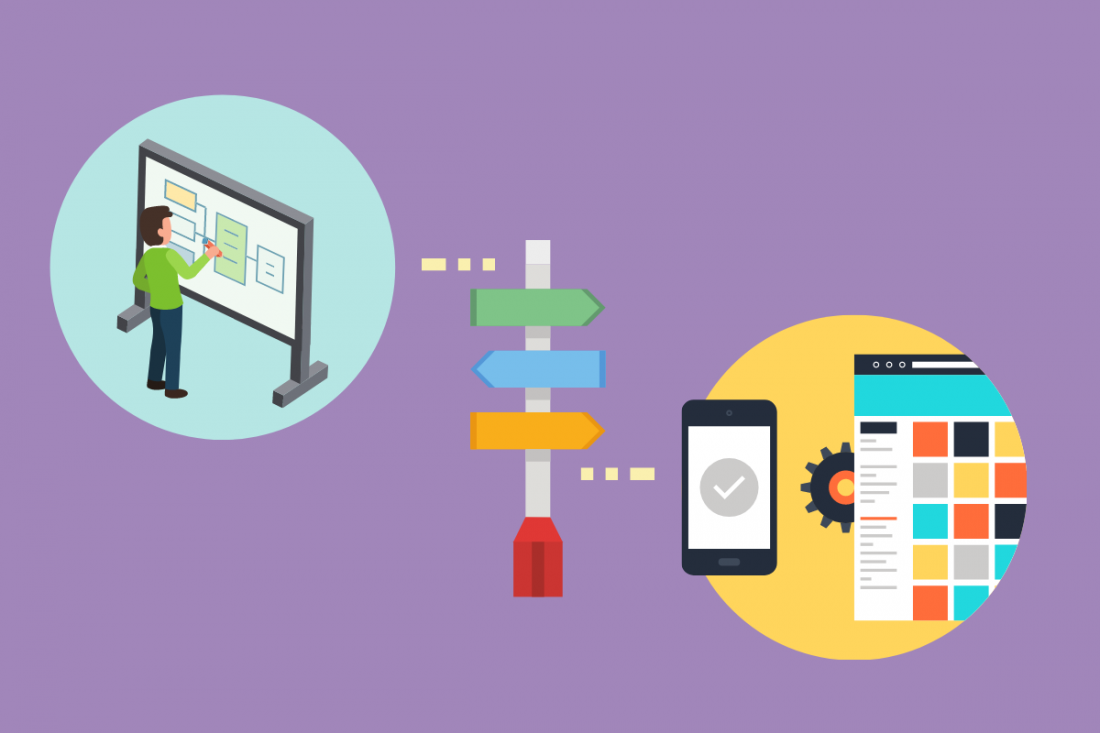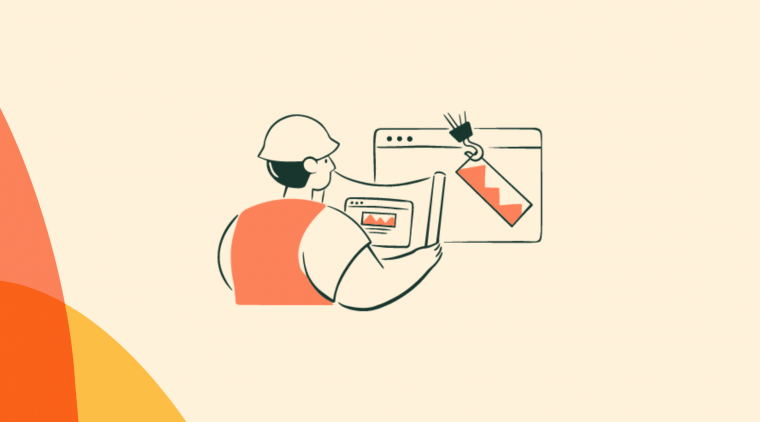When a product team is creating a new product, they go through several stages. At first, during the product ideation—they feel inspired and come up with tons of new and fresh ideas. But after all the research and information, this initial idea becomes more and more like a giant wool ball, and you, as the product manager, have to find a way to unravel it and find a way to maximize your product's business value.
So, how can you do that? The right tools and good communication are keys to getting closer to a great product. And those are the foundations of the feature prioritization techniques. After all, making decisions can be challenging since, in most cases, we have to give up something. When we have limited resources (technology, people, time), all the variables are just as important as the rest. We have to deliver a functioning product. How can we decide what’s best? What features should we put on top of our list? What should we leave out?
As a product manager, you probably face this dilemma every time you set your foot in the office—or home office. Product owners want all the features for the first sprint. From their perspective, all features are essential, while product designers know that’s not necessarily true.
Some tools can help us design our product strategy, helping us learn to what degree each feature is replaceable, which is a matter of life and death. At the same time, it is essential not to lose focus on our product's indispensable features. Who are we targeting with each release? We also need to accurately monitor and measure our user satisfaction to incorporate their feedback into our product strategy.
Let's imagine that we're working on a product, for instance, an e-commerce platform for which our product owners explicitly requested the following features:
List of products
Shopping cart
Chat
Login
Register
Subscription / Newsletter
Discount
When asked, they're going to claim that they all are equally important. They know what product features the client wants – they want them ALL, and they want them... NOW!
How do you prioritize product features?
As previously mentioned, before thinking about features, or getting into what prioritization frameworks we should use, we must analyze our target audience's primary needs to satisfy them. Product managers need to rewire their approach to make the customer needs' the core of their proposal and their product roadmap.
After all, this customer-centric approach permeates technology product management nowadays and virtually every step of 21st-century companies, no matter what industry they belong to. It shouldn't be different when discussing potential features.
“Becoming customer-centric doesn’t happen overnight. You need to take a step back and evaluate how you currently stack up before you can begin to improve.”
Let's hear how Rachel Obstler, EVP Product at Heap, prioritizes building features.
So, what is the first step for feature prioritization?
We should do two things before starting the path towards our North-Star objective—complete and utter customer satisfaction.
1. Product analysis
Awareness: What does the discovery flow look like? Can potential customers find us through Google, social ads, review sites, etc.? How is the messaging—is it consistent or confusing?
Consideration: What questions would a customer have? Are there any objections or challenges that would arise? What motivations do we think they have when they decide to sign up?
Purchase: What is encouraging prospects to purchase—or discouraging them?
Service: How is the overall in-product experience? How does your onboarding process look? Is there help available at any time?
Loyalty: How long do customers stay around before churning out? Is there a referral process in place? Can users get additional features or priority support?
Returning to our example, we could highlight the features “chat” and “newsletter” from the list provided by our product owners. Our product prioritization analysis showed that these potential features would contribute to having more fluid communication with our clients, ultimately helping product management understand their needs.
2. The Kano Model
Another useful feature prioritization tool is what's known as the Kano Model. This theory, created in 1984 by Professor Noriaki Kano, classifies customer preferences into specific categories. Thanks to this prioritization framework, product managers and teams can predict customers’ satisfaction with product and service features, using the premise that it will depend on functionality.
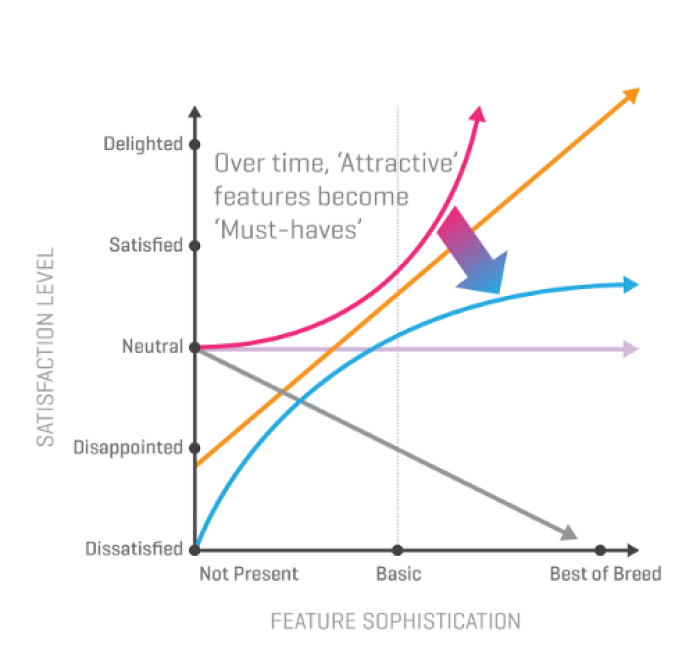
(Credit: UX Booth & Jan Moorman)
This product prioritization system is divided into 5 categories:
Threshold Attributes
These are basic features that customers expect, and while they might not be dazzled by them, it would be unsatisfactory not to have them. A perfect example of this is a search bar to find products on e-commerce sites.
Performance Attributes
The sort of features that don’t come with the original product deal. Instead, PMMs add them to improve the overall satisfaction level. A beautiful color palette selection with a nice font not only contributes to creating an eye-catching design but contributes to UX by preventing user mistakes when navigating it. Small details such as this will contribute to getting our users to spend more time using our product.
Excitement Attributes
These are the critical features that increase the product's edge, distinguishing it from the competition. By researching other products in the market, product managers can set the product strategy to build better features such as easier registration, faster service, or improved customer communication channels.
Indifferent Attributes
Features that customers cannot decide if they think they are good or bad. A good example of these would be changing our logo. It might generate some opinions but won't have any effect on the functionality.
Reverse Attributes
These features can be related to lower quality or performance and could decrease satisfaction levels. Intrusive advertising is one of the main attributes in this category.
5 strategies for feature prioritization
Once we've performed a little product "soul-searching," it is time to REALLY start with the process. There are quite a few feature prioritization frameworks you can have in your tool belt. Some of them focus on how urgent the feature is, while others are more linked to the value vs effort ratio. Silver bullets are a thing of the past, especially in the customer-centric world we currently live in. Product managers need to know by heart all these methods and be proficient when it comes to a specific prioritization framework to make the right call at any given moment.
Here are some of the most relevant:
MoSCoW method
No, this technique has no relationship with the capital of Russia nor any other Euro-Asian country whatsoever. This feature prioritization technique takes its name from the acronym M (Must have), S (Should have), C (Could have), W (Won't have). It is one of the most common, used by, among others, stakeholders to understand the significance of initiatives in a specific release.
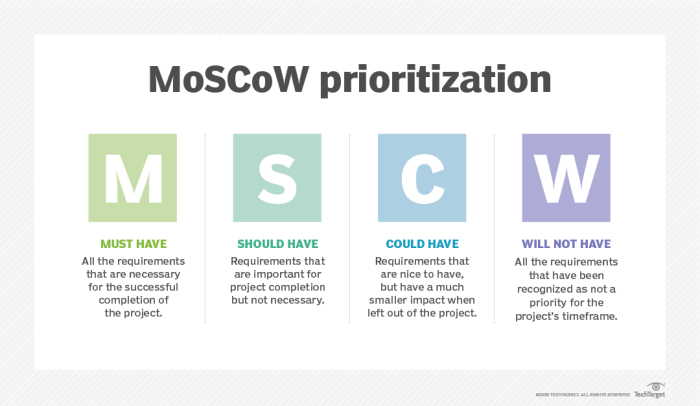
(Credit: Search software quality)
This prioritization framework consists of 4 different categories:
Must-haves: non-negotiable features.
Should-haves: important features.
Could-haves: nice to have features.
Will-not-haves: lower priority features.
The main goal is to assign those labels to each feature to convey their objectives properly.
Before using this prioritization framework, the stakeholders and the product manager need to align the general objectives, the product strategy, and prioritization factors. Then they can discuss how the product team will settle any disagreements if necessary, and finally make some product decisions by defining the resources to allocate to each category.
RICE Score
The RICE framework looks at the following focus areas when discussing a potential feature:
Reach: the number of customers that will be reached with a particular feature.
Impact: the impact score from 0,25 lowest to 3 the highest.
Certain: the percentage of certainty that you have, based on research or statistics.
Effort: effort based on a relation person - month.
Hence the acronym RICE. Once you have all the numbers, you can work that feature prioritization magic by using the equation to get the final RICE score:
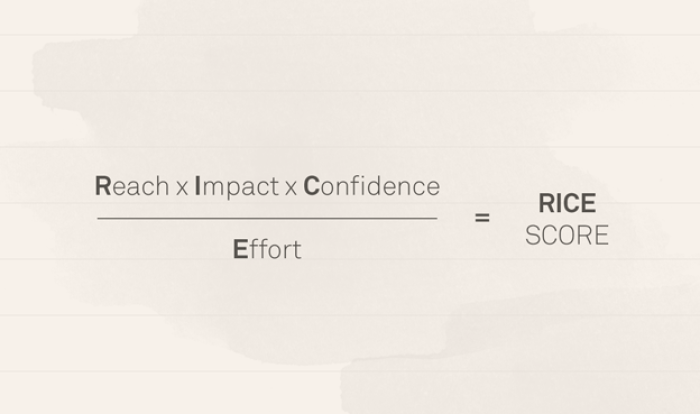
The RICE framework allows product managers to have an overview of their predictions. Keep in mind, the RICE method is a quantitative strategy, and in some cases, might not be the most effective. Nevertheless, if you want to have a more objective way of finding high-performance features, it might come in handy.
Impact vs Effort Matrix
Are you a visual thinker? Then this product prioritization framework is for you. This technique visually represents all the features based on the product and the technical point of view. In this case, it’s necessary to assign points to each feature both from the product/functional perspective and based on the technical effort.
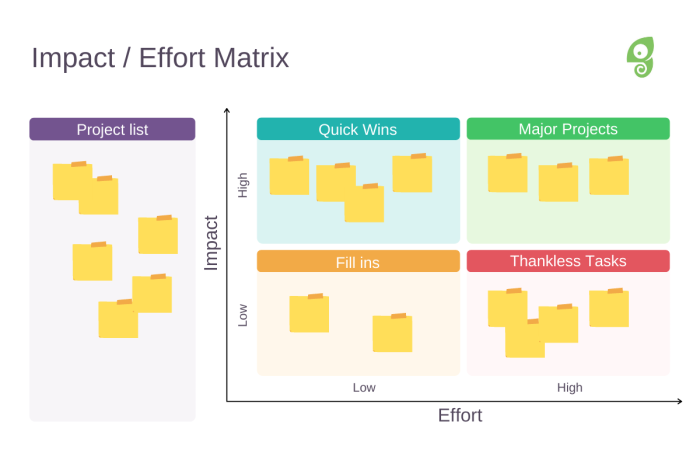
You’ll come up with your feature positioned in a cartesian matrix, with the impact being the Y-axis and the effort as the X-axis. You can now quickly analyze your product roadmap.
This technique helps prioritize features more clearly, identifying and proposing to others a clear path that allows us to find the right solution.
Priority Scorecard
With this specific method, any product manager and their team can quantify each feature's priority by designing their own categories.
Along with the other members of your team, define each category and assign them a symbolic weight. Now you can provide 100 points by type to each meeting participant. After a discussion to make sure everybody is on the same page, they can start assigning their points and prioritizing features.
Pro tip: create different categories for product teams and technical teams and analyze the same feature list classifying them based on that Scorecard. That will your feature prioritization process will provide easy features that can have an impact on customers.
Opportunity Scoring
Also known as opportunity analysis or gap analysis, this feature prioritization framework sheds light on features that users consider both important and undeveloped. Opportunity scoring is a great way to detect new opportunities while reducing risks, thanks to heavily relying on customer feedback.
If a feature is regarded as of high importance but low satisfaction, teams should improve it. On the contrary, if a feature receives a low score in both satisfaction and importance, it can be left and move the creative efforts elsewhere. And lastly, if users consider a feature booth satisfactory and important, management can prioritize new ways of improving the ROI by stepping up the innovation related to this feature.
How product managers can handle feature prioritization in their product team
Each project has a different context, issues, resources, goals, etc. However, let's go back to our first case example. How to prioritize features in a new project such as e-commerce?

Well, creating a user story map would be a good start. Using a method like MoSCoW will allow you to identify your priorities and goals while defining your customers. With all that information, you can group features by epics and have a possible path to follow. Don’t worry if, at a certain point, that product roadmap changes. It happens to the best of us, and it is actually a healthy sign of being able to adapt the product in an agile and lean way.
Now, let's imagine we talk with all stakeholders, and they already know what they want for their next release. But we still need to work on the product development plan and prioritize features that add value and bring high impact to customers.
Example of a prioritization framework using the MoSCoW method
After conducting the process, the final list would look a little bit like this one.
List of products (Must)
Shopping cart (Should)
Chat (Could)
Login (Must)
Register (Must)
Subscription / Newsletter (Will not have)
Discount (Could)
With that in mind, a product manager would take all the "Must" features and create the first release. The rest ("Should" and "Could" features) will have to wait for subsequent releases. You can also group all features related to Users and create an Epic, and then gather all features related to the products and sales and create a second and a third one:
Epic: Users
Epic: Sales
Epic: Communication
Release nº 1
Login
Register
Shopping Cart
List of products
Release nº2
Change Password
Discount
Chat
Subscription / Newsletter
Release nº3
Forgot Password
Select Color
Select Size
Email Campaign
When it comes to other contexts, for example, an ongoing project, prioritization can use a little bit of helpful user feedback, as long as you have deployed the right tools for collecting it, such as user surveys.
Product managers need to prioritize features properly by selecting the right method. The Kano Model is a great one if you are trying to add new features. Whenever you have a mountain of work or don’t have enough resources, the Impact vs. Effort Matrix will fit. It’s vital to select the method thoroughly. Sometimes you’ll have to take a step back and see the product strategy big picture to find the right way of prioritizing features.

Why should PMMs use product prioritization techniques when making decisions?
Product managers need a concrete definition, with documentation and ordered priorities. Unfortunately, most of the time, that doesn't happen. It’s a widespread situation for PMMs to find themselves sitting at their desks thinking about the goals of the features they are working on, wondering: “Does the customer want to customize the back button to his e-commerce?” “Does this feature satisfy a client or just an executive?”. What feature prioritization can do for them is bring a little order to their product strategy.
We all have biases. The right way to tackle them is having close communication with the different departments of our product. The agreements and disagreements between team members can be baffling and a source of friction if there is no strong culture within the company, and everybody trusts each other. The way to tackle this is data-fueled prioritization, so every decision about a feature has some data to back it up.
Only with data, will you be able to set a strong base to make a decision. We need to balance our team's views with the cold hard data. We're all working in the same direction—a product that really DELIVERS. A well-established easy-to-follow process to prioritize features can help us find the right combination while allowing team members to do their best to achieve product success.

Is there a right answer when it comes to prioritizing features?
For product feature prioritization, there are no correct answers. There will also be risks. You can carefully decide upon which feature requests to pull to the top of the list based on painstaking research on customer value, and you can still fail.
In the end, finding the right features lies in fluent communication with your team and your users, creating substantial synergy.
Each tool has been created with a purpose to solve a particular problem. But still, not everything has been discovered. Product teams need to keep looking, researching, reading, and experimenting with new frameworks, even take the best of each, and create our own feature prioritization framework. After all, each product, each team, and even each customer is its own micro-universe. Embracing the prioritization process is the way to bring order to that natural chaos that is a product feature.
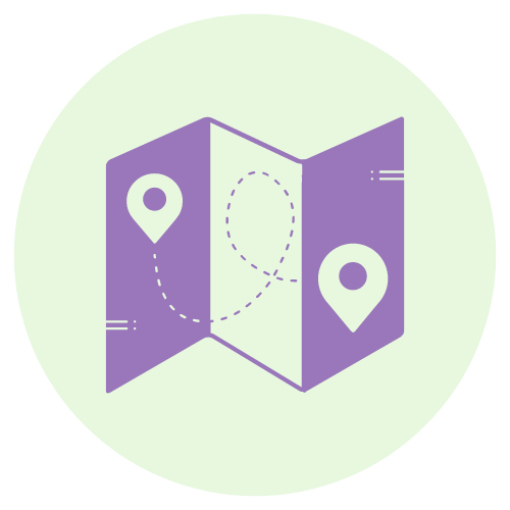
Get the Right Features on Your Product Roadmap
Discover how to gather specific feedback that guides your roadmap with microsurveys—check out our on-demand webinar.
